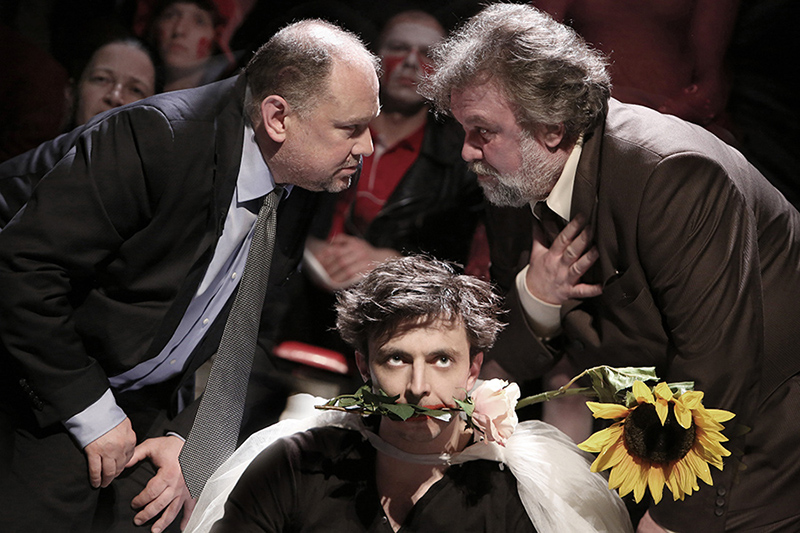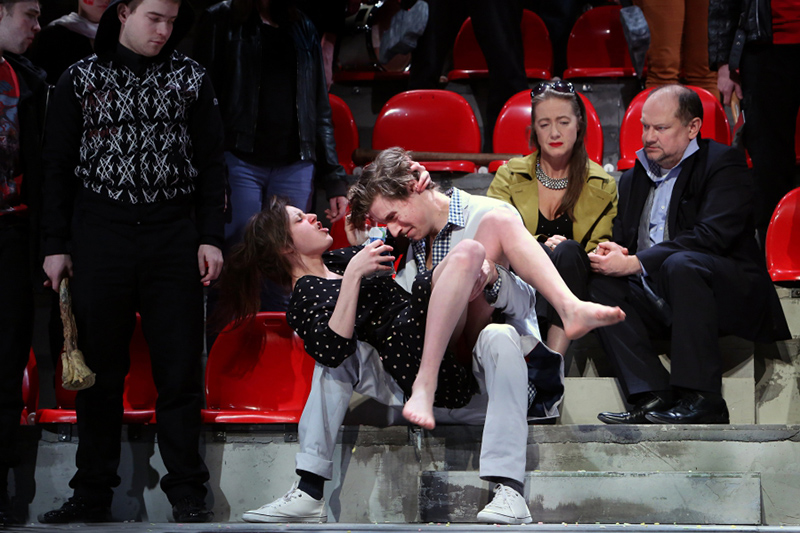A review of Örkény Theatre’s production of Shakespeare’s Hamlet (dir. Bagossy László) by Komáromi Tímea
What characterises the performance of Hamlet in Örkény Theatre is modern thinking. Putting Shakespeare – or any other Renaissance play – into a 21st century context is always a challenge, one that not all adaptations can fully rise to. In the case of Bagossy’s Hamlet, the modernity of the production meets the expectations to a certain extent, but in some cases it becomes too much to take in. For example, at the very end Fortinbras takes his cell phone and takes a photo of the dead royal family which carries the whole performance too far.
Even so, the modern understanding of the performance does offer some enjoyable solutions, such as the premise – the actors fit nicely into the set of a football stadium as Danish spectators. This setting works especially well with certain parts of the play, making Bagossy’s adaptation shine in those scenes in particular. The premise proves to be an especially clever idea when, for example, at the end of the play the Danish characters lie dead on the ground after the duel scene, and all the spectators then are Norwegian, or when Ophelia returns the gifts she received from Hamlet, and the characters sitting on the tribune start throwing all kinds of objects towards Hamlet, such as toys, pieces of women’s clothing, and a sunflower. It is an action clearly indicating that Hamlet is unwanted in court, and in this production, this is reinforced by the fact that almost all of the actors are spectators and they throw the gifts on stage as one body.
The production also owes a lot of its strength to its actors. Polgár Csaba, who plays Hamlet, builds up his character remarkably well: his simple but straightforward gestures give life to a Hamlet who brings a new level of faked insanity to the character, the complexity of which comes in how sensitive but at the same time how neurotic he is. Alongside Polgár’s Hamlet, Kókai Tünde gives a good performance in the similarly difficult role of Ophelia, whose insanity can be tough to portray well. But Kókai rises to the challenge, managing to bring something awe-inspiring to the stage and letting the audience watch in astonishment as her Ophelia transitions from a vulnerable girl to a demented one. I can only agree with Bedő J. István’s statement in his review that at first sight Kókai’s Ophelia is hardly noticeable on purpose, so that when she becomes demented, it is all the more powerful. The audience receives not the usual melancholic figure but a wild and visibly insane person instead, who, for instance, in an unexpected moment of extreme madness, takes her underwear off and urinates on stage.
Aside from the madness that is so admirably performed by both Polgár and Kókai, however, the overall tone and direction of the play appears to be too comic, at least for my taste. I did not have the impression that I was watching a play that was originally written as a tragedy. Still, taking the production’s comedic tone into consideration, I appreciated that the duel scene was somewhat unconventional and there was only Horatio’s recounting of the events which the actors performed with minimal movement.
Though somewhat dissonant for my taste, it is that comedic tone, along with the unique setting of the production, that makes Bagossy’s Hamlet an innovative adaptation. Pataki Anita appropriately states in her review that it does not really matter whether the audience knows how the play originally ends because this modern version of Hamlet offers a new experience, exactly because it lacks the uneasiness that usually follows the staging of modern reinterpretations of classics.
Read our other Hamlet reviews here, and all theatre reviews here!
Images taken from Örkény Theatre’s Hamlet gallery, photographed by Gordon Eszter.




